
How AI Can Help You Plan Your Travel Activities
Planning a trip is exciting, but figuring out what to do once you get there can sometimes feel like a full-time job. Whether you’re vacationing in Hawaii, visiting friends in another state, or heading off on a business trip, AI can be a surprisingly helpful assistant when it comes to organizing your daily activities and discovering the best your destination has to offer.
This article isn’t about booking flights, hotels, or rental cars — I’ll cover that in a separate piece focused on AI agents. Here, the focus is on how AI can make activity planning smoother, more interactive, and far more personalized than using traditional travel websites.
Your Personal Trip Planner
Instead of spending hours jumping between travel blogs, review sites, maps, and itineraries, you can have a conversation with AI. Imagine telling it, “I’m going to Oahu for 7 days — help me plan each day.” The AI can suggest popular attractions, hidden gems, scenic drives, family-friendly options, or even day trips based on your interests. You can then refine those suggestions with simple follow-ups like, “Make sure I have a beach day,” or “Add one fancy dinner with an ocean view.”
The experience feels more like chatting with a travel-savvy friend than doing research. You don’t have to start from scratch or manually piece together recommendations — the AI builds your itinerary with you, step by step, based on your preferences.
Smarter Than a Search Engine
AI doesn’t just pull the most obvious answers from a list. When connected to search capabilities, it can surface upcoming events, seasonal festivals, or new openings that might not even show up on the first page of a traditional search engine. For example, if a major concert is happening during your visit or a special art exhibit just opened, the AI can include that in your plan.
Unlike locals who may not always know about every trend or upcoming event, or static guidebooks that quickly become outdated, AI combines recent data and broad knowledge. You can ask about food spots, accessibility, scenic viewpoints, or even which beaches are less crowded at certain times of the day — all without opening a dozen tabs or reading through lengthy blog posts.
Itineraries That Evolve With You
One of the biggest benefits of planning travel activities with AI is how easy it is to adapt on the fly. Real trips rarely go exactly as planned. You might want to sleep in one day, skip an activity due to rain, or discover something more exciting once you arrive. Instead of canceling everything or reworking your whole schedule manually, you can just tell the AI what you want to change and let it adjust the itinerary.
Say it starts raining while you're walking around downtown — you can ask the AI to swap in a nearby indoor activity. If you're tired of hiking after two days, you can ask it to replace the next one with a spa or food tour. It makes your schedule feel more responsive, allowing the trip to flow with your energy and interests rather than locking you into a rigid plan.
The Little Tips That Save Your Day
AI can also help with the small but important local tips that travelers often overlook. For instance, sunscreen tends to be surprisingly expensive in tourist-heavy areas of Hawaii, so it’s better to bring your own. Parking in many popular spots — especially downtown or near major beaches — can be incredibly difficult to find, and it’s worth planning ahead or opting for rideshares when possible.
There are also practical details like checking whether certain hikes require advance reservations or if a restaurant you're eyeing closes early. These aren't major changes to your trip, but knowing them in advance can make the difference between a smooth day and an avoidable headache.
Keeping the Conversation Going
One of the most enjoyable parts of using AI for trip planning is that it feels like an ongoing conversation. You build your plan one activity at a time, and the AI keeps track of your preferences and changes. However, most AI tools only remember what’s happening in the current conversation. If you step away and come back later, it helps to have your itinerary saved somewhere — even a short version with your destination, dates, and a few confirmed plans is enough.
When you’re ready to continue, you can paste that summary back into the chat and the AI will quickly get back up to speed. It’s a simple habit that makes it easier to take breaks and pick up where you left off, without having to start all over again.
The Future of Travel Is Interactive
Planning travel activities with AI doesn’t take away the thrill of discovering a new place — it enhances it. It lets you focus more on enjoying the trip and less on organizing it. You get a flexible itinerary tailored to your tastes, local tips that keep you a step ahead, and the freedom to change your mind anytime without stress.
And while I’m focusing here on planning what to do during your trip, AI agents are also evolving to help with booking flights, hotels, and transportation. That’s a topic I’ll explore in a future article. For now, if you’re preparing for your next adventure, don’t overlook what AI can already do. It just might be the best travel companion you didn’t know you needed.
